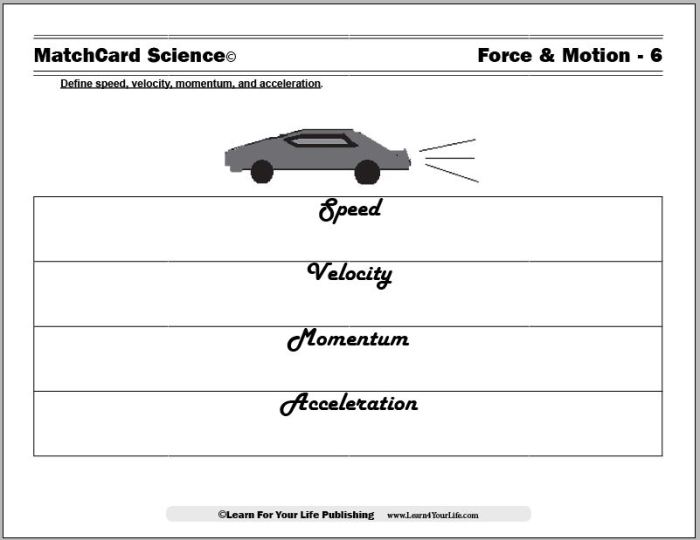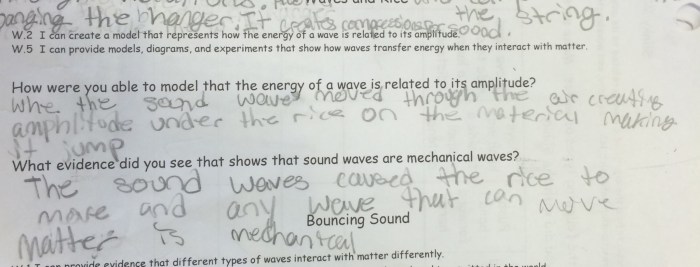Delve into the realm of physics with our comprehensive Worksheet on Speed and Velocity, meticulously crafted to provide an immersive learning experience. This meticulously curated resource unveils the intricate concepts of speed and velocity, equipping you with a profound understanding of these fundamental aspects of motion.
Prepare to embark on an enlightening journey as we unravel the intricacies of speed and velocity, exploring their real-life applications, examining the factors that influence them, and delving into the captivating world of sports, where speed and velocity reign supreme.
Introduction
Speed and velocity are two fundamental concepts in physics that describe the motion of objects. Speed is the rate at which an object covers distance, while velocity is the rate at which an object changes its position.Speed is a scalar quantity, meaning it has only magnitude, while velocity is a vector quantity, meaning it has both magnitude and direction.
The SI unit of speed is meters per second (m/s), while the SI unit of velocity is meters per second per second (m/s²).Real-life examples of speed include the speed of a car (e.g., 60 km/h) or the speed of a runner (e.g.,
4 m/s). Real-life examples of velocity include the velocity of a falling object (e.g., 9.8 m/s²) or the velocity of a projectile (e.g., 10 m/s at an angle of 30 degrees).
Types of Speed and Velocity
Speed and velocity are two closely related concepts that describe the motion of objects. Speed is the rate at which an object covers distance, while velocity is the rate at which an object changes its position.
Average Speed
Average speed is the total distance traveled by an object divided by the total time taken. It is a measure of the overall speed of an object over a given period of time.
To calculate average speed, use the following formula:
Average Speed = Total Distance / Total Time
For example, if a car travels 100 kilometers in 2 hours, its average speed is 50 kilometers per hour (km/h).
Instantaneous Speed
Instantaneous speed is the speed of an object at a specific instant in time. It is the limit of the average speed as the time interval approaches zero.
To calculate instantaneous speed, use the following formula:
Instantaneous Speed = lim (Δx / Δt) as Δt
> 0
where Δx is the change in position and Δt is the change in time.
For example, if a car’s speedometer reads 60 km/h, then its instantaneous speed is 60 km/h.
Speed and Velocity Calculations

Calculating speed and velocity involves using specific formulas that relate distance, time, and displacement. Understanding these formulas is essential for accurately determining the motion of objects.
Speed Calculation
Speed is the rate at which an object covers distance, regardless of its direction. It is calculated using the formula:
Speed = Distance / Time
Where:
- Speed is measured in meters per second (m/s), kilometers per hour (km/h), or miles per hour (mph).
- Distance is the total distance traveled by the object in meters (m), kilometers (km), or miles (mi).
- Time is the duration of the motion in seconds (s), hours (h), or minutes (min).
Applications of Speed and Velocity
Speed and velocity are fundamental concepts in various fields, providing insights into motion and change over time. Understanding these concepts is crucial for analyzing and predicting real-world phenomena.
Physics
- Calculating Kinetic Energy:Velocity is essential for determining the kinetic energy of an object, which is crucial for understanding energy transformations and motion.
- Describing Motion:Speed and velocity provide quantitative measures of an object’s motion, allowing physicists to describe and analyze trajectories, acceleration, and other motion-related characteristics.
Engineering, Worksheet on speed and velocity
- Designing Vehicles:Velocity is a key factor in vehicle design, determining factors such as fuel efficiency, performance, and safety.
- Fluid Dynamics:Speed and velocity are crucial for understanding fluid flow, which has applications in areas such as aerodynamics, hydraulics, and oceanography.
Sports
- Performance Analysis:Velocity measurements help athletes and coaches analyze performance, identify areas for improvement, and optimize training strategies.
- Game Strategy:Understanding speed and velocity is essential for developing effective game strategies in sports like soccer, basketball, and baseball.
Graphing Speed and Velocity

Graphs are useful tools for visualizing and analyzing speed and velocity. They can help us understand the relationship between these two quantities and how they change over time.
Types of Graphs Used to Represent Speed and Velocity
- Speed-time graphsshow the speed of an object as a function of time. These graphs can be used to determine the average speed of an object, as well as its instantaneous speed at any given time.
- Velocity-time graphsshow the velocity of an object as a function of time. These graphs can be used to determine the average velocity of an object, as well as its instantaneous velocity at any given time.
Examples of Speed-Time Graphs and Velocity-Time Graphs
The following are examples of speed-time graphs and velocity-time graphs:
- Speed-time graph:A speed-time graph for an object that is moving at a constant speed would be a straight line. The slope of the line would be equal to the speed of the object.
- Velocity-time graph:A velocity-time graph for an object that is moving at a constant velocity would also be a straight line. The slope of the line would be equal to the velocity of the object.
Speed and Velocity Measurement Devices: Worksheet On Speed And Velocity
Measuring speed and velocity accurately is essential in various fields, including transportation, sports, and scientific research. Several devices have been developed to measure these quantities, each with its own principles of operation, accuracy, and limitations.
Speedometers
Speedometers are commonly used in vehicles to indicate the speed at which the vehicle is traveling. They typically measure the rotational speed of the wheels and use a mechanical or electronic mechanism to convert this rotation into a speed reading.
Speedometers are relatively inexpensive and easy to use, but their accuracy can be affected by factors such as tire wear, road conditions, and vehicle modifications.
Radar Guns
Radar guns are handheld devices that use radar technology to measure the speed of moving objects. They emit a beam of radio waves and measure the frequency shift of the reflected waves to determine the object’s speed. Radar guns are commonly used by law enforcement agencies to enforce speed limits, but they can also be used in sports and other applications.
Radar guns are generally accurate, but their effectiveness can be limited by factors such as the presence of multiple moving objects, interference from other radar sources, and weather conditions.
GPS Devices
GPS (Global Positioning System) devices use satellite signals to determine the position and speed of an object. By tracking the change in position over time, GPS devices can calculate the speed and velocity of the object. GPS devices are widely used in navigation systems, fitness trackers, and other applications.
They offer high accuracy, especially when combined with other sensor data such as accelerometers and gyroscopes. However, GPS signals can be affected by factors such as atmospheric conditions, satellite visibility, and signal interference.
Factors Affecting Speed and Velocity
Speed and velocity can be influenced by various factors, including mass, force, and friction. These factors play a crucial role in determining the motion of an object.
Mass
Mass refers to the amount of matter in an object. According to Newton’s second law of motion, the acceleration of an object is inversely proportional to its mass. This means that objects with greater mass require more force to achieve the same acceleration compared to lighter objects.
For example, a car with a heavier mass will require more force from the engine to accelerate than a lighter car. This is because the heavier mass of the car resists the change in motion more than the lighter car.
Force
Force is an external influence that can cause an object to change its motion. According to Newton’s second law of motion, the acceleration of an object is directly proportional to the force applied to it. This means that applying a greater force to an object will result in a greater acceleration.
For example, a car with a more powerful engine will accelerate faster than a car with a less powerful engine. This is because the more powerful engine exerts a greater force on the car, resulting in a greater acceleration.
Friction
Friction is a force that opposes the motion of an object. It arises from the interaction between two surfaces in contact. Friction can reduce the speed and velocity of an object.
For example, when a car moves on a road, friction between the tires and the road surface opposes the motion of the car. This friction reduces the speed and velocity of the car.
Speed and Velocity in Sports
Speed and velocity play crucial roles in various sports activities, impacting performance and outcomes. Understanding these concepts is essential for athletes seeking to enhance their abilities and achieve optimal results.
Importance of Speed and Velocity in Sports
- Faster Acceleration:Speed and velocity determine an athlete’s ability to accelerate quickly, which is critical for sports like sprinting, cycling, and swimming.
- Improved Agility:High velocity allows athletes to change direction and respond to sudden movements with greater agility, enhancing their performance in sports like basketball, soccer, and tennis.
- Increased Endurance:Velocity and speed training can improve an athlete’s endurance by increasing their lactate threshold, enabling them to maintain a higher speed for longer durations.
li> Enhanced Recovery:Velocity training has been shown to improve an athlete’s recovery time, allowing them to train harder and more frequently without excessive fatigue.
Essential Questionnaire
What is the difference between speed and velocity?
Speed measures the rate of change in an object’s position, while velocity measures the rate of change in an object’s position in a specific direction.
How do I calculate average speed?
Average speed is calculated by dividing the total distance traveled by the total time taken.
What are some factors that can affect an object’s speed and velocity?
Factors that can affect an object’s speed and velocity include mass, force, and friction.

